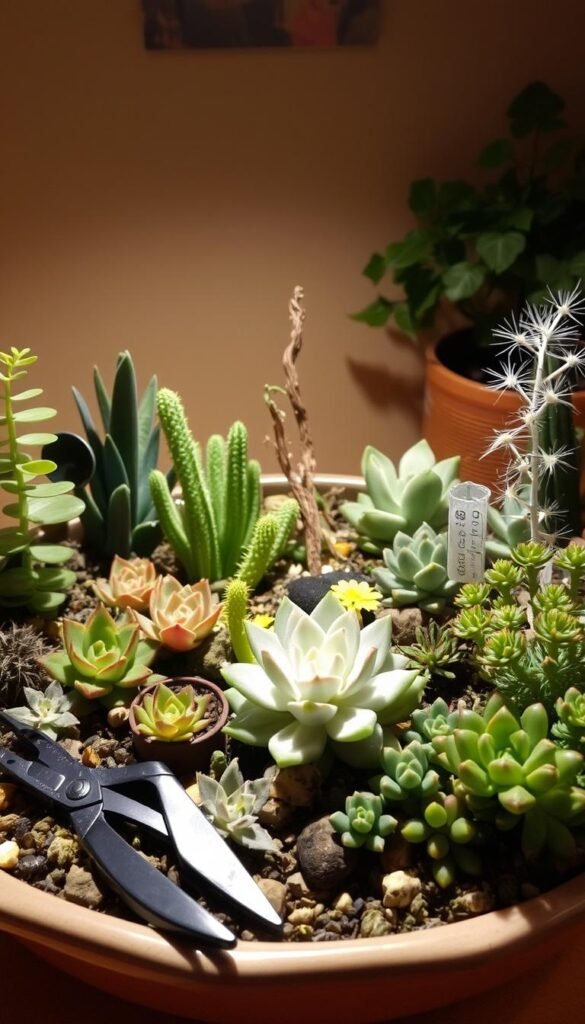Did you know over half of American homes nurture plants indoors or outdoors? A 2023 study by Bigger Garden reveals 55% of U.S. households grow something, whether herbs on windowsills or backyard veggies. But as seasons shift, many wonder how to sustain their favorite greenery when temperatures drop and daylight fades.
Here’s the good news: you don’t need to abandon your passion when frost arrives. With smart strategies, even small indoor setups can thrive through winter. This guide shares simple, proven methods to adapt your routine without extra stress or hours of work.
Imagine plucking fresh basil in January or enjoying vibrant blooms during gray November days. It’s possible by learning how light, water, and temperature affect growth year-round. We’ll break down common mistakes—like overwatering in cooler months—and show you how to avoid them.
Whether you’re new to growing or a seasoned pro, these tips fit any schedule. You’ll discover how to adjust care for seasonal changes and keep plants lively without constant attention. Let’s turn your space into a lush retreat that defies the calendar.
Introduction to Your Year-Round Garden Journey
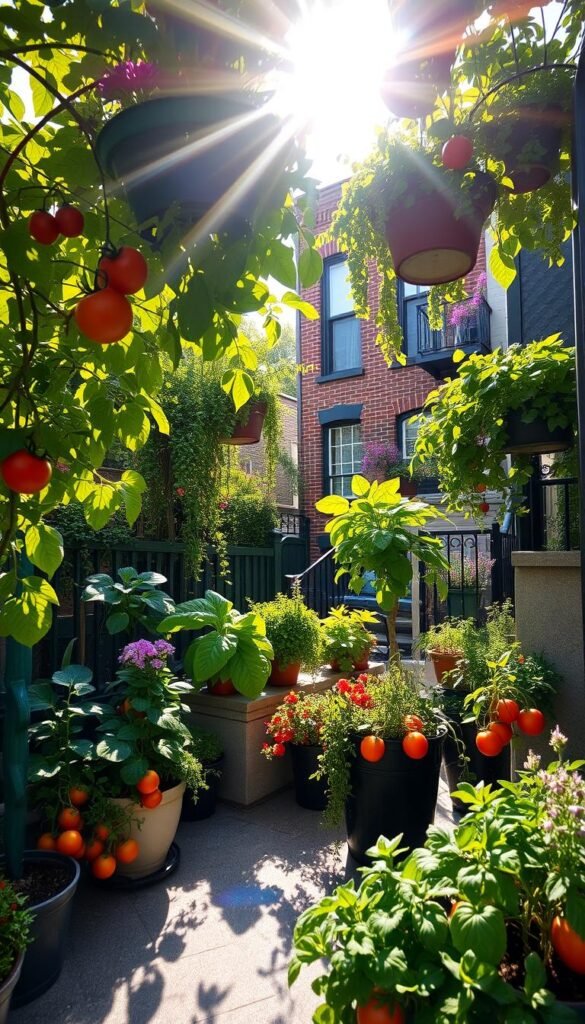
Transform your patio or deck into a vibrant oasis that adapts to every season. Container setups let you grow fresh ingredients steps from your kitchen while sidestepping common outdoor challenges.
Discover the Benefits of a Dish Garden
Growing in pots gives you unique advantages. You’ll spend less time battling pests and more time enjoying harvests. Move containers to chase sunlight or shield delicate varieties from harsh weather.
| Factor | Container Setup | In-Ground Gardening |
|---|---|---|
| Pest Control | Fewer soil-based invaders | Regular infestations |
| Maintenance | Watering simplified | Hose dragging required |
| Space Use | Flexible arrangements | Fixed locations |
What to Expect from This How-To Guide
We’ll show you how to pick perfect pots and pair plants for continuous growth. Learn seasonal tricks like rotating mint to shade-loving ferns when summer heat fades.
Our methods help you work with nature’s rhythm. Expect practical advice on soil mixes, watering schedules, and plant combinations that thrive together. Turn small spaces into productive hubs that surprise you with their bounty.
Planning Your Dish Garden for Seasonal Success
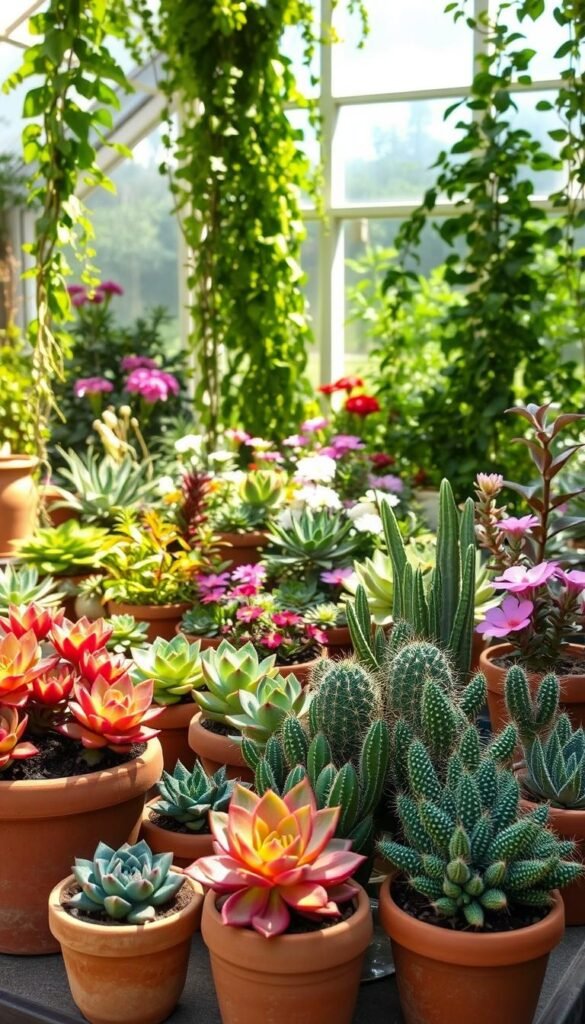
Designing a thriving container setup begins with smart spatial planning. Start by walking around your deck or balcony with fresh eyes. Look for railings that could hold window boxes and stairs wide enough for ceramic pots. These features become your garden’s backbone.
Assessing Your Space and Light Conditions
Grab a notebook and track sunlight patterns for three days. Mark areas that get morning rays versus afternoon blaze. Remember: summer sun angles differ from winter’s low arc. A corner baking in July might become December’s perfect spot for shade-loving ferns.
Check your deck material too. Composite surfaces handle moisture better than untreated wood. Use saucers under pots to protect surfaces and prevent slippery conditions.
| Location | Summer Light | Winter Light | Best Plant Types |
|---|---|---|---|
| Railing Boxes | 6+ hours | 3 hours | Herbs → Kale |
| Under Overhang | Partial shade | Full shade | Begonias → Moss |
| Stair Pots | Morning sun | Indirect light | Marigolds → Pansies |
Creating a Seasonal Garden Plan
Rotate plants like you’d swap wardrobe items. Heat-lovers like basil claim prime sunny real estate May-September. When frost threatens, replace them with cold-hardy greens in the same space. Keep a calendar noting which spot hosts which crop each month.
Sketch your layout seasonally. Color-code areas by light exposure. This visual guide helps you match plants to their ideal light needs year-round. You’ll waste less money on varieties that can’t handle your microclimate.
Essential Gardening Tools and Maintenance Routines
Sharp tools make gardening smoother and more efficient. Proper care extends their lifespan while protecting your plants from disease. Let’s explore simple habits that save time and reduce work over seasons.
Cleaning and Storing Your Tools
After each use, wipe dirt from pruners and shovels. A 10-minute scrub with mild bleach solution prevents rust and stops pathogens from spreading. Dry metal parts thoroughly, then apply mineral oil to blades. Don’t forget wooden handles—a linseed oil rub keeps them splinter-free.
| Task | Frequency | Tools Needed | Benefit |
|---|---|---|---|
| Disinfecting | After each use | Bleach, brush | Prevents disease |
| Sharpening | Every 6 weeks | File, gloves | Cleaner cuts |
| Storage Prep | Seasonally | Oil, cloth | Long-term protection |
Regular Garden Check-Ups
Set weekly reminders to inspect leaves and stems. Early pest detection means less maintenance later. Check soil moisture with your finger—overwatering causes more issues than drought in container setups.
Rotate pots every 2-3 weeks for even growth. This simple trick improves plant symmetry without extra work. For detailed guidance on sanitizing equipment, explore our guide to proper sterilization methods.
“Well-maintained tools are like good friends—they support you through every gardening challenge.”
Create a dedicated storage zone for frequently used items. Hang pruners on pegboards and stack pots vertically. Seasonal tools belong in labeled bins—you’ll thank yourself next spring.
Optimizing Soil, Drainage, and Moisture for Robust Growth
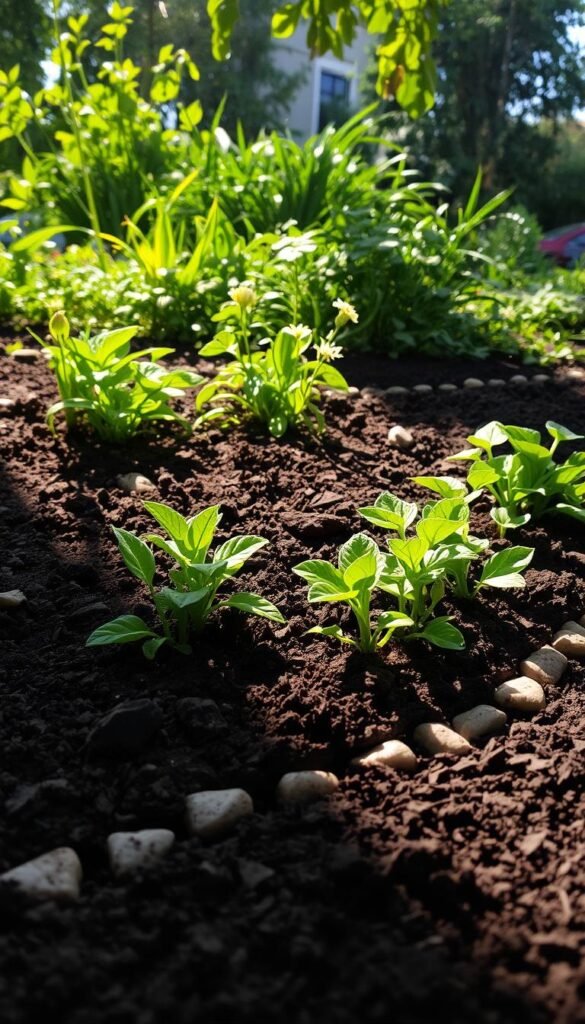
Healthy plants start from the ground up—literally. The right foundation prevents root suffocation and nutrient loss. Let’s explore how to create ideal conditions through smart soil management and watering habits.
Improving Soil Quality and Nutrients
Premium potting mixes like Miracle-Gro offer better drainage than regular dirt. Their fluffy texture lets roots breathe while holding enough moisture. For existing containers, refresh the top 2 inches of soil each season to replenish organic matter.
Nutrient loss accelerates in containers. Pair watering with a water-soluble fertilizer—Miracle-Gro’s formula feeds plants instantly. This approach replaces minerals washed away during frequent irrigation.
“Soil is a plant’s stomach—it needs constant nourishment to support growth.”
Watering Techniques Across Seasons
Summer demands daily checks—poke your finger an inch deep. If dry, water until it drains from the bottom. In cooler months, wait until the topsoil feels slightly crumbly.
| Season | Watering Frequency | Key Tips |
|---|---|---|
| Summer | 1-2x daily | Morning & evening sessions |
| Fall/Spring | Every 2-3 days | Check forecast for rain |
Always use containers with drainage holes. For clay pots, line the base with gravel before adding prepared soil mix. This prevents clogging while maintaining airflow.
Green Thumb Boost: Keeping Your Dish Garden Healthy Year-Round
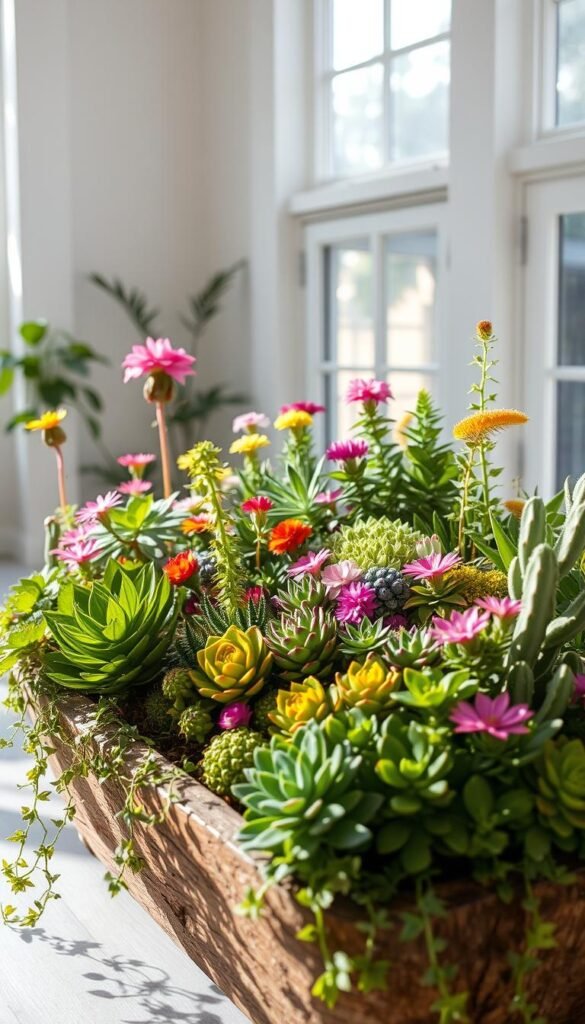
Gardening doesn’t pause when temperatures drop—it evolves with nature’s rhythm. Observe how plants slow their growth in cooler months. This isn’t failure—it’s survival mode. Your role shifts from frequent tending to strategic support.
Leave spent stems standing through winter. Ladybugs and lacewings shelter in hollow stalks, while seed heads feed finches. Cut back perennials in spring when new shoots appear, not during fall cleanup. This simple delay protects your garden’s tiny allies.
Watch for subtle cues like leaf droop or slowed growth. These signal when to reduce watering or move pots to brighter spots. Rotate crops every 8-10 weeks using cold-hardy crops like kale and spinach as temperatures dip. Indoor herb kits extend harvests without overcrowding windowsills.
Feed container plants monthly with diluted fertilizer during active growth. Pause applications in dormancy periods to prevent root burn. A light mulch layer insulates soil without smothering stems.
“Successful growers think like their plants—anticipating needs before stress appears.”
Embrace messy corners where leaves decompose naturally. This builds soil structure and shelters earthworms. Your garden thrives when you work with seasonal shifts, not against them.
Seasonal Planting Strategies and Varieties
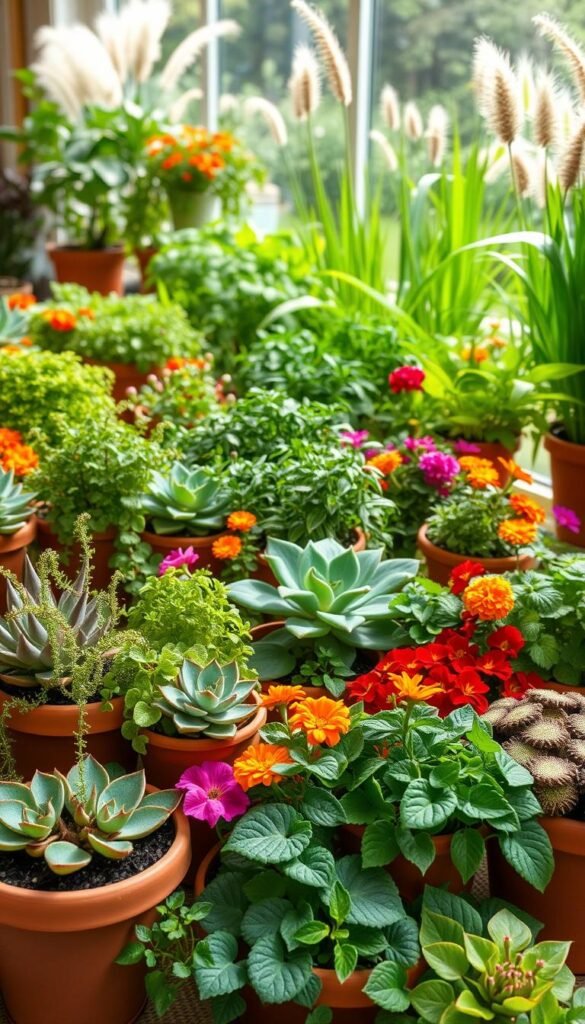
Nature’s calendar offers perfect pairings for every planting phase. Match your selections to seasonal strengths, and you’ll enjoy vibrant growth with less effort. Smart timing turns ordinary containers into year-round performers.
Plant Partners for Every Climate Window
Cool-season varieties like spinach thrive when temperatures dip below 70°F. Pair them with kale and snap peas for fall-to-winter harvests. Come spring, swap these for heat-loving tomatoes and peppers that bask in summer sun.
| Season | Top Performers | Key Features |
|---|---|---|
| Spring | Lettuce, Radishes | Fast growth, cool roots |
| Summer | Basil, Zucchini | Sun worshipers |
| Fall | Kale, Carrots | Frost-tolerant |
Mastering the Division Dance
Autumn’s mild days create ideal conditions for splitting perennials. Peonies and irises recover faster when divided 4-6 weeks before hard frosts. The cooler nights reduce transplant shock while moist soil encourages root development.
- Divide spring bloomers after flowers fade
- Cut back foliage by one-third before splitting
- Water deeply post-transplant
“Dividing in fall feels like helping friends move—they settle in comfortably before winter’s rest.”
Track your local first frost date using regional guides. This ensures new divisions establish properly. Rotate crops annually to prevent soil nutrient depletion and pest buildup.
Nurturing Indoor Greens and Containers on Your Deck
Your kitchen windowsill holds more potential than you might realize. Modern growers blend technology with creativity to cultivate fresh flavors and textures—even in compact spaces. Let’s explore how to maximize every inch of your indoor and outdoor zones.
Hydroponics and Windowsill Herb Gardens
LED grow lights revolutionize year-round cultivation. These energy-efficient setups let you grow basil or parsley through winter’s darkest days. Start with shallow-rooted varieties like chives or lettuce—they thrive in small pots with minimal space.
For soil-free options, try hydroponic kits. They’re perfect for beginners craving instant results. No-fail herbs to grow in containers like mint and thyme adapt well to water-based systems. Harvest leaves weekly to encourage bushier growth.
Selecting and Upcycling Containers
Old mugs, tin cans, and wooden crates become unique plant homes with proper drainage. Drill holes in non-porous materials to prevent waterlogged roots. Match container depth to your crop—6-inch pots suit radishes, while deeper ones accommodate carrot taps.
Rotate containers on your deck every 3-4 days for even sun exposure. Group moisture-loving plants in glazed ceramic pots that retain water longer. This simple trick reduces watering frequency during summer heat waves.

